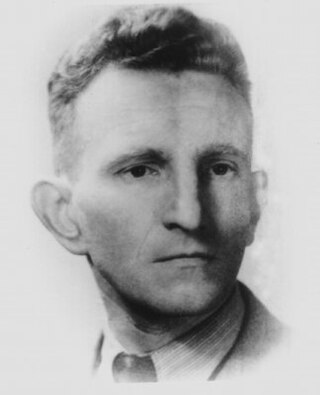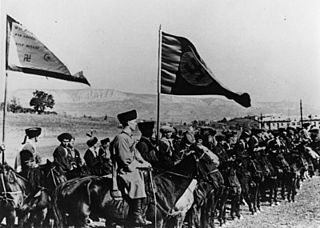
The massacres of Poles in Volhynia and Eastern Galicia were carried out in German-occupied Poland by the Ukrainian Insurgent Army (UPA) with the support of parts of the local Ukrainian population against the Polish minority in Volhynia, Eastern Galicia, parts of Polesia and the Lublin region from 1943 to 1945. The ruling Germans also actively encouraged both Ukrainians and Poles to kill each other.

Stepan Andriyovych Bandera was a Ukrainian far-right leader of the radical militant wing of the Organization of Ukrainian Nationalists (OUN-B).

The Ukrainian Insurgent Army was a Ukrainian nationalist paramilitary and partisan formation founded by the Organisation of Ukrainian Nationalists on 14 October 1942. During World War II, it was engaged in guerrilla warfare against the Soviet Union, and both the Polish Underground State and Communist Poland.
The Organisation of Ukrainian Nationalists was a Ukrainian nationalist organization established in 1929 in Vienna, uniting the Ukrainian Military Organization with smaller, mainly youth, radical nationalist right-wing groups. The OUN was the largest and one of the most important far-right Ukrainian organizations operating in the interwar period on the territory of the Second Polish Republic. The OUN was mostly active preceding, during, and immediately after the Second World War. Its ideology has been described as having been influenced by the writings of Dmytro Dontsov, from 1929 by Italian fascism, and from 1930 by German Nazism. The OUN pursued a strategy of violence, terrorism, and assassinations with the goal of creating an ethnically homogenous and totalitarian Ukrainian state.

A partisan is a member of an irregular military force formed to oppose control of an area by a foreign power or by an army of occupation by some kind of insurgent activity.

Roman-Taras Yosypovych Shukhevych was a Ukrainian nationalist and a military leader of the nationalist Ukrainian Insurgent Army (UPA), which during the Second World War fought against the Soviet Union and to a lesser extent against the Nazi Germany for Ukrainian independence. He collaborated with the Nazis from February 1941 to December 1942 as commanding officer of the Nachtigall Battalion in early 1941, and as a Hauptmann of the German Schutzmannschaft 201 auxiliary police battalion in late 1941 and 1942.

Anti-Bolshevik Bloc of Nations (ABN) was an international anti-communist organization founded as a coordinating center for anti-communist and nationalist émigré political organizations from Soviet and other socialist countries. The ABN formation dates back to a conference of representatives of non-Russian peoples that took place in November 1943, near Zhytomyr as the Committee of Subjugated Nations/the Anti-Bolshevik Front on the initiative of the Organization of Ukrainian Nationalists. It dissolved in 1996.

Yaroslav Semenovych Stetsko was a Ukrainian politician, writer, ideologist and Nazi collaborator, who served as the leader of Stepan Bandera's faction of the Organization of Ukrainian Nationalists, the OUN-B, from 1941 until his death. During the German invasion of the Soviet Union in 1941, he was named the temporary head of an independent Ukrainian government which was declared in the act of restoration of the Ukrainian state. During 1942-1944 was imprisoned in Sachsenhausen concentration camp. After the WW2, Stetsko was the head of the Anti-Bolshevik Bloc of Nations until his death in 1986.

The Lviv pogroms were the consecutive pogroms and massacres of Jews in June and July 1941 in the city of Lwów in German-occupied Eastern Poland/Western Ukraine. The massacres were perpetrated by Ukrainian nationalists, German death squads (Einsatzgruppen), and urban population from 30 June to 2 July, and from 25 to 29 July, during the German invasion of the Soviet Union. Thousands of Jews were killed both in the pogroms and in the Einsatzgruppen killings.

Mykola Kyrylovych Lebed or Lebid, also known as Maksym Ruban, Marko or Yevhen Skyrba, was a Ukrainian nationalist political activist and guerrilla fighter. He was among those tried, convicted, and imprisoned for the murder of Polish interior minister Bronisław Pieracki in 1934. The court sentenced him to death, but the state commuted the sentence to life imprisonment. He escaped when the Germans invaded Poland in 1939. As a leader of OUN-B, he was responsible for the massacres of Poles in Volhynia and Eastern Galicia.
Yuriy Demyanovych Lopatynsky, nom de guerre Sheyk and Kalyna, was a Ukrainian activist, soldier and a colonel in the Ukrainian Insurgent Army.

A large number of Soviet citizens of various ethnicities collaborated with Nazi Germany during World War II. It is estimated that the number of Soviet collaborators with the Nazi German military was around 1 million.
Ukrainian People's Militsiya or the Ukrainian National Militsiya, was a paramilitary formation created by the Organization of Ukrainian Nationalists (OUN) in the General Government territory of occupied Poland and later in the Reichskommissariat Ukraine during World War II. It was set up in the course of Operation Barbarossa, the 1941 invasion of the Soviet Union.
The Litopys UPA volume series was created under the auspices of the Litopys UPA Publishing Company, an Ontario Corporation Without Share Capital incorporated in 1978. Publishing primary source, archival material and documents, and first person accounts that relate to the military history of the Ukrainian Insurgent Army UPA, underground resistance organizations, as well as the history of Ukraine during World War II and post war decade. Each volume or group of volumes is devoted to a specific theme. Some deal with the military history in a specific period of time or region - for example, in Volyn, in Halychyna, as in the regions of Ukraine under Poland and so on. Two, three, or more volumes may be devoted to specicific themes. Memoirs, or books by individual authors dealing with particular questions offer insight into individual topics. Ukrainian language with English introductions.

"Glory to Ukraine!" is a Ukrainian national salute, known as a symbol of Ukrainian sovereignty and resistance to foreign aggression. It is the battle cry of the Armed Forces of Ukraine. It is often accompanied by the response "Glory to the heroes!".
A Banderite or Banderovite was a member of OUN-B, a faction of the Organization of Ukrainian Nationalists. The term, used from late 1940 onward, derives from the name of Stepan Bandera (1909–1959), the ultranationalist leader of this faction of the OUN. Because of the brutality utilized by OUN-B members, the colloquial term Banderites quickly earned a negative connotation, particularly among Poles and Jews. By 1942, the expression was well-known and frequently used in western Ukraine to describe the Ukrainian Insurgent Army partisans, OUN-B members or any other Ukrainian perpetrators. The OUN-B had been engaged in various atrocities, including murder of civilians, most of whom were ethnic Poles, Jews and Romani people.

The National Museum-Memorial of Victims of the Occupation Regimes, or the Prison on Łącki (Street) is a former detention center in Lviv, Ukraine, that throughout the 20th century was primarily used as a political prison of the Soviet and Nazi regimes.
The special groups of the NKVD for fighting against nationalists were units set up by the People's Commissariat for Internal Affairs of the Soviet Union mainly in territories annexed by the USSR before the German-Soviet war due to the Molotov–Ribbentrop Pact, in particular they fought against the OUN and UPA in Ukraine, the Forest Brothers, in the Baltic states and against the Belarusian Black Cats, a special unit of the Schutzstaffel. They were also known as the Agent-Combat Groups (ABG), legend groups, false UPA detachments and the NKVD units dressed as UPA fighters.
Yevhen Pavlovych Stakhiv was a Ukrainian nationalist militant in the Donbas during World War II and a member of the Organization of Ukrainian Nationalists.

The anti-Soviet resistance by the Ukrainian Insurgent Army was a guerrilla war waged by Ukrainian nationalist partisan formations against the Soviet Union in the western regions of the Ukrainian SSR and southwestern regions of the Byelorussian SSR, during and after World War II. With the Red Army forces successful counteroffensive against the Nazi Germany and their invasion into western Ukraine in July 1944, UPA resisted the Red Army's advancement with full-scale guerrilla war, holding up 200,000 Soviet soldiers, particularly in the countryside, and was supplying intelligence to the Nazi Sicherheitsdienst (SD) security service.













